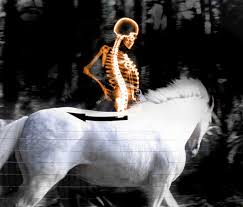 According to the US Department of Health, 75-80% of all adults will experience back pain. Indeed, low back pain is the leading cause of disability in adults under age 45.(1) Due to the concussive forces inherent to riding and the potential for falls from height, equestrians are particularly susceptible to back pain and injuries. Incorrect riding posture and postural weaknesses most certainly are contributing factors to riders developing chronic back pain. To complicate matters, saddle type and stirrup length can play a role in increasing the potential for back pain.(2)
According to the US Department of Health, 75-80% of all adults will experience back pain. Indeed, low back pain is the leading cause of disability in adults under age 45.(1) Due to the concussive forces inherent to riding and the potential for falls from height, equestrians are particularly susceptible to back pain and injuries. Incorrect riding posture and postural weaknesses most certainly are contributing factors to riders developing chronic back pain. To complicate matters, saddle type and stirrup length can play a role in increasing the potential for back pain.(2)
The body’s natural response to pain is to protect the area that hurts and compensate by relying on some other muscle or joint to take up the slack. This not only upsets our ability to ride freely and without holding in our bodies, but also sets us up for secondary pain in the compensatory muscle or joint. It can be assumed that if the rider’s body is compensating and not evenly seated on the horse, the horse’s back is also going to experience negative effects.
So, how do we riders prevent back problems before they begin? And what do we do if we already have back injuries or pain? Here are some strategies to prevent back injuries and strain, improve or alleviate already painful backs for riders:
Strengthen, Strengthen, Strengthen
Every rider needs a stable core to ride correctly. Even more importantly, a strong core protects the back. Many fitness programs do a lot of work on abdominal muscles, but only some directly strengthen the back. For greatest core stability, choose a workout program that has the following elements:
-
Addresses the low deep abdominal, psoas and hip flexor muscles, as well as the muscles of the lower and mid-back.
-
Incorporates balance exercises where core stability is challenged – on a balance ball, for example.
-
Includes whole-body core exercises such as planks rather than targeting individual muscles for high burst-strength training.
If you have a current injury, work with your doctor or chiropractor to develop an appropriate physical therapy plan that will bring you back to full function before starting a workout program.
Mind your Ps and… Rs
Posture and Relaxation are critical elements in not only protecting your back, but also in riding well. In some Western riding disciplines you might see professionals slouching in presumed total relaxation, but if you ask them, they are often riding with back pain. It has become quite popular in the Hunt Seat as well as the Saddle Seat rings for the rider to be “posed” with a hollow back, a recipe for future back pain. Event riders often show a rounded (often called “roached”) back during the cross country round. This is a symptom of fatigue, which will ultimately result in back strain without greater strengthening. For all disciplines, good posture with relaxation is critical to protecting your back from strain. A strong core allows for both good posture and proper relaxation.
According to Dr. Jason Ablett, Doctor of Chiropractic in Kirkland, Washington, yoga is the most effective spine health habit one can practice. As it turns out, yoga is also extremely beneficial for riders in many ways, and will help protect the rider’s back from strain while riding. It has the added benefit of developing great riding posture. We have incorporated some of the most powerful yoga poses for spine health into the Ridefit program, making it a fantastic whole-body workout that is perfect for helping riders protect and improve their back health!
None of us should have to suffer pain while riding, especially pain that can be as debilitating as back pain. Fortunately, it is possible to improve your spine health and reduce, eliminate, or prevent back pain while riding. Here’s to your back!
1 Source: Bigos S, et al. Acute Low Back Problems in Adults, Clinical Practice Guideline No. 14. Rockville, MD: U.S. Public Health Service, U.S. Dept. of Health and Human Services, AHCPR Pub. No. 95-0642, Dec. 1994.
2 Quinn, S., & Bird, S. (1996). Influence of saddle type upon the incidence of lower back pain in equestrian riders. British Journal of Sports Medicine, 30(2), 140–144.
Speak Your Mind